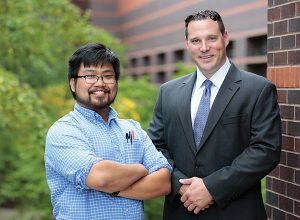
Engineering ideas and technologies enhance human performance, preserve safety and quality of life
Developing telerobotics control systems, applying biomechanics for improved sports performance, creating visualization tools that improve battle space awareness. These projects and more are going on within the Augmentation and Training of Humans with Engineering in North America Lab.
The lab, known as ATHENA Lab for short, is one of four labs of its kind in the world. And the only one the Augmented Human International Conference Series recognizes in North America.
“We want to make humans more capable and safer, and we’re using a mix of ergonomics, augmented reality and cutting-edge technologies to accomplish our goals,” says Richard Stone, an associate professor of industrial and manufacturing systems engineering, co-director and co-founder of the lab.
The ATHENA Lab evolved from the Human Performance and Cognitive Engineering Lab that Stone started when he came to Iowa State in fall 2008. Fast forward to 2015 and bring in Thomas Schnieders, a Ph.D. student in industrial engineering and the other co-director and co-founder of the lab, who talked with Stone about the potential of having a recognized human augmentation lab on campus.
“The ATHENA Lab takes what we were already doing and gives us more focus. It also shows us other areas where we could be adding value with our work,” explains Schnieders. “A lot of labs do great work individually in biomechanical, biomedical and cognitive science, but our lab tries to merge all these aspects to see how they work together.”
No two days at the ATHENA Lab are similar. The researchers are constantly running new experiments, testing body armor one day and the next they might be focused on figuring out what technologies could make wound suturing more consistent.
“Our setup is always changing, and we’re moving equipment around all the time,” Stone adds. “At any time you might see boxes of basketball shoes stacked to the ceiling or maybe robots tucked away on a shelf. It just depends on what problem we are working to solve.”
The ATHENA Lab is also equipped with a large variety of sensors, cameras, hardware and software the researchers use to gather data.
Stone says the students who work in the lab bring a lot of energy and excitement to the projects. “The work we are doing is very focused. They get to work on projects they can apply to their everyday life, and they get to see the end results of their time and effort,” he explains. “It’s fun to see young students come in and show them a different side of engineering.”